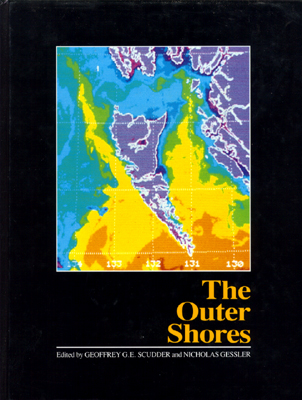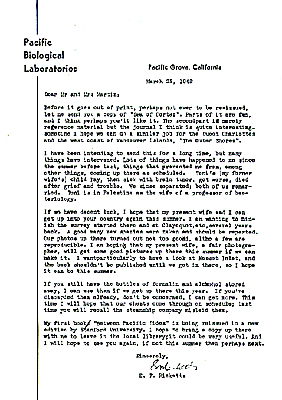 =====
=====
 =====
=====
excerpts...
PREFACE
Most readers will probably be aware of the character Doc in John Steinbeck's novel Cannery Row, and the inspiration for that character, marine biologist Ed Richetts. Ricketts, who wrote Between Pacific Tides and who collaborated with Steinbeck on The Log From the Sea of Cortez, visited the Queen Charlotte Islands in 1946 and was to have returned to the islands in 1948 for an extensive collecting trip. John Steinbeck was to have joined him in working the material up into a new book entitled The Outer Shores. Clarence Martin, of Masset, was prepared to assist them (see letter on following page). But the trip was never made owing to Ricketts' tragic death. Steinbeck wrote about their plans:
At the time of Ed's death our plans were completed, tickets bought, containers and collecting equipment ready for a long collecting trip to the Queen Charlotte Islands, which reach so deep into the Pacific Ocean. There was one deep bay with a long and narrow opening where we thought we might observe some changes in animal forms due to a specialized life and a long period of isolation. Ed was to have started within a month and I was to have joined him there. Maybe someone else will study that little island sea. The light has gone out of it for me.
John Steinbeck
"About Ed Ricketts"
The Log From the Sea of Cortez
His eulogy seems somewhat prophetic in light of our own symposium which stressed the evolutionary uniqueness of the Queen Charlotte Islands. One cannot help but wonder how the interests in these islands might have changed had they completed their work. And for these reasons it seemed fitting to use the title The Outer Shores for this volume, as a tribute to science and its public appreciation, and the spirit of independence and exploration embodied in their work.
We are especially pleased to learn that the notes of Ed Ricketts' trips to the Charlottes were edited by Joel Hedgpeth and published in 1978 under the same title at the Mad River Press, Eureka, California. It is an admirable book which we commend to our readers.
While these papers based on the proceedings of the First International Scientific Symposium on the Queen Charlotte Islands have taken some time to get published, we trust the volume will aid in an understanding of this unique area. The text clearly falls into three parts, each of which is introduced by a short synopsis. The final overview and synthesis aims to summarize the general findings and recent developments on the area, that has been called "Canada's Galapagos".